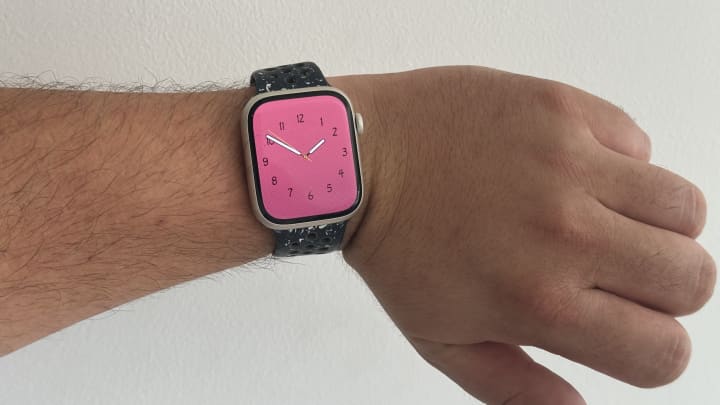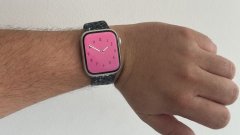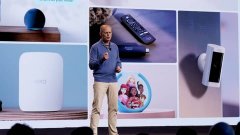
is releasing new Apple Watch models, called Series 9, on Friday.
The new Apple Watches look nearly identical to older models. This year's version comes in the same two display sizes as last year — 41mm and 45mm — and it can still monitor your heart rate, record workouts, and display notifications from a paired iPhone. There's also a higher-end version made out of titanium, called the Ultra.
I've been testing a 45mm aluminium Apple Watch Series 9 for a few days.
If you've ever had an Apple Watch, the new models won't be a major surprise — Apple's wearable continues to excel at fitness tracking and boasts tight integration with the iPhone. There aren't new sensors on this year's watches, the design remains the same as it's been since 2018, and the screen is the same size as it's been since 2021.
But the Series 9 comes with a faster chip that enables new features, including a major improvement to Siri and a gesture that should make it easier to use with your hands full, which offers a preview of how people may interact with Apple's Vision Pro VR headset. They're the same price as last year's models.
Here's what's new in this year's Apple Watches:
The biggest new change on the new Apple Watch is a new way to interact with it: a gesture that doesn't require tapping the screen or pressing a button.
It's called "double tap," and it's simple to use: Raise your arm up, like you're checking the time, to activate the Apple Watch, then click your thumb and index finger twice. In testing, I found it also worked with my middle finger. Sensors inside the Apple Watch, including the accelerometer and heart rate sensor, detect that you've tapped, an icon appears on the top of the Watch home screen, and you feel a little bit of haptic feedback.
This is the first time that the Apple Watch has been able to sense a gesture made with the user's hands, except for a few niche accessibility features. Apple says the feature is convenient to interact with your watch when your hands are busy, like if you're walking the dog or holding a coffee.
In most Apple Watch apps, the double tap selects the primary action, or the most obvious button. When you do it on your watch face, by default, it brings up a new scrolling screen of widgets with weather, Apple News headlines, and calendar appointments.
The tap motion also stops alarms, ends phone calls, and can even trigger the iPhone's shutter button, depending on which Watch app you're using.
The most useful example is when you start a workout — a run, or a long walk — and forget to start it on the watch. The device often picks up that you're working out and asks if you want to log the workout. Now, instead of tapping on the device's screen, you can just raise your watch and double tap to start the workout.
In testing, I didn't find the double tap to be an indispensable daily gesture for me, although it was fun to play around with, and the haptic feedback when it works is satisfying.
Nor did I find the "smart stack" widget that the double tap brings up to be that useful — I generally don't like widgets, and the suggestions it made by default were not helpful, like a card with tips for my new Apple Watch. The individual widgets are selected through machine learning, so it could get better with use.
The gesture also requires the Apple Watch interface to be activated, with its backlight on. You can't just double tap when your arm is at your side. Instead, you have to raise your arm to wake the display first, then tap your fingers twice, which makes it feel like a much more exaggerated motion.
In an interesting twist, the "double tap" is a nearly identical gesture to the on the Vision Pro, Apple's VR headset that's coming out next year. Apple has framed that device as a "new era for computing" based on its user interface, a concept it calls " ." The Vision Pro uses sophisticated sensors detect hand motions and other gestures, allowing the user to interact with it in 3D space, rather than simply by tapping a screen. The new Apple Watch gives a glimpse into that world.
From a pure technology perspective, it shows that as Apple introduces its version of mixed reality through its headset, it will also be bringing parts of that user interface to its other products that already ship in the tens of millions.
Double tap won't be on by default with the Watches going on sale Friday. Instead, it will be activated through a software update in the coming month, specifically for the latest watches. Apple provided an Apple Watch Series 9 with pre-release software for this review.
The other big improvement in this year's watches is an updated central chip, which Apple calls a System-in-Package, or SiP. It has 60% more transistors, according to Apple, and a 30% faster GPU.
The old Apple Watches always seemed responsive enough to me, and the chip doesn't make the watch immediately feel snappier, but it's the first major update to the Watch's processor in a number of years. Most notably, it enables a much faster Siri which doesn't need to be connected to the internet.
Now, when you give a voice command to your watch, your command is processed on the device, from translating it from spoken word to text to understanding what it's asking for. If Siri doesn't need to connect to the internet, the whole command can happen without a cellular or WiFi connection.
The main thing I noticed is that on-device Siri feels much quicker when responding. In the past, I've avoided using my Apple Watch as a Siri interface because I found commands can time out with a weak Wi-Fi connection. I found myself preferring my Apple Watch over a HomePod or my phone for simple tasks like setting a kitchen timer, or quick questions like finding out when a particular game is on TV.
The on-device processing also allows Siri to access your health data, which Apple typically protects by default. Siri on the watch couldn't do things like log weight through a voice command or tell you whether you took your medications because it had to be sent to the cloud for processing. On-device Siri will be very convenient for people who need to check a vital stat or log data on a daily basis.
The other big hardware improvement to the Apple Watch Series 9 is a brighter display. Apple says the new models can go up to 2000 nits of brightness, versus 1000 for last year's models.
In indoors environments, like a home or office, the brighter display won't be particularly noticeable. Where you can notice it is outdoors, in direct sunlight, where the brighter panel on the new devices pops a little bit more, and makes text, especially in white, slightly more solid-looking.
Apple Watches don't allow the user to choose a specific brightness level, but instead offer one of four different settings that auto-adjusts based on the exterior conditions.
It's nice-to-have but not a must-have upgrade, especially since many people don't have their Apple Watches set to the maximum brightness to begin with. But people who spend all day outdoors with their watches will appreciate it, and I'd rather have the brighter screen than not have it.
This year isn't a big year for the Apple Watch — there's no new design or sensor that would lead people to covet the latest model. The old watches, like the new ones, still can track sleep, alert authorities if you're in a crash, show notifications, and download apps.
At $399 for the smallest screen and $429 for the larger version, the Apple Watch Series 9 isn't a cheap upgrade for a faster chip and a brighter display. This year, Apple also released an updated low-end Apple Watch, the SE, which at $249 and up matches what Apple Watches from a few years ago can do, but without this year's improvements like the double tap gesture or the new chip.
I think that most people getting an Apple Watch for the first time should get a mainstream Apple Watch Series 9 over the SE if they can afford it — it will likely last longer and will be more capable to receive new features in the coming years.
Users may also wonder whether it's worthwhile paying the additional $400 to get an Apple Watch Ultra, which has a longer battery life and several features for serious athletes. The Ultra got an update with the new chip this year, but CNBC didn't get to test it.
One group of users who might want to upgrade even if they have last year's versions are people who are invested in Apple's ecosystem and want to see how the company may embrace new kinds of user interfaces, like with the double tap gesture. If you're planning to get a $3499 Vision Pro headset, a $400 watch is not a huge expense if you want a preview of how Apple's gestures work.
But ultimately, for most people with current Apple Watches that are in working order, I don't think the Series 9 is a necessary upgrade.



